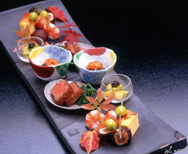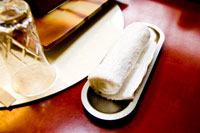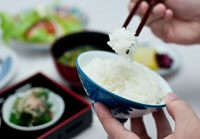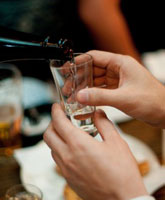"Japanese food" is no longer the food for Japanese only. It prevails all over the world. Most people are accustomed to typical Japanese food such as sushi and tempura. However, some seem to be worried about the way they are eating, including the readers of this newsletter. We’ve got a number of requests for an explanation of table etiquettes in Japan. So here we go! Before starting, we would like to ask our readers not to worry too much! Food is food, and what is most important is to enjoy it!
When you enter the restaurant, a waiter or a waitress will offer you a wet towel or a wet piece of paper. It is to wipe your hands to refresh yourself. If they serve it with a bamboo or plastic tray, please put it on the tray after you wipe your hands so that you can use it again whenever you need. It is rude to make noise while eating as here in the U.S. but there are a few notable exceptions: when you eat Japanese noodles (soba, udon, ramen, somen, whatever), when you have miso soup. You may be surprised to hear you should rather make noise when you drink up a cup of tea at the end of a tea ceremony to show your content with the service, so you should practice it!
Others are manner rules universal: don’t speak with your mouth full, and close your mouth while you are chewing. What’s special for Japanese food is perhaps the use of chopsticks. Please avoid holding food with two pairs of chopsticks. It is believed to bring bad luck because it reminds us of a ritual behavior at funerals. If you want to pass food to another person, put it on a plate once so that the other can take it with his or her own chopsticks. It is not preferable to stick your chopsticks to the food, especially to a rice bowl, because it is the same way to offer a bowl of rice to the tablet of the deceased. Speaking of a rice bowl, it is better to hold the bowl with your hand, while scooping rice with chopsticks with the other hand. It is not only well mannered, but also reasonable to prevent the food from dropping.
You may have seen that Japanese pour drinks for others at parties. It is more polite to use both hands when you pour sake and to hold your glass while the drink is being poured to you. Both gestures show respect from one to another. At the end of the day, it is not rude at all to pay the bill without tips!! Japan is a no tipping country. Usually service charge is included in a bill. If you think the service is extremely great, it is OK to pay the extra money but some even refuse to accept it. Did I mention too many dos and don'ts? As mentioned above, one needn't worry too much. Because there are countless Japanese restaurants here in the U.S., I hope this article will be of some help even if you're not going to Japan soon. Enjoy Japanese food and bit of its culture! For more, please visit here!























































